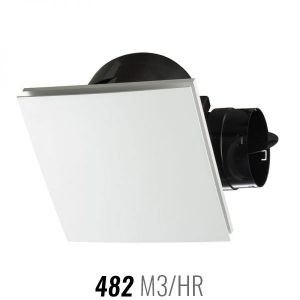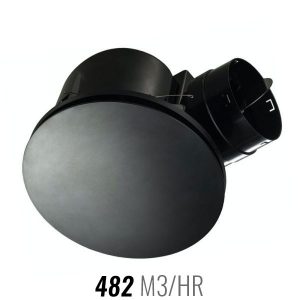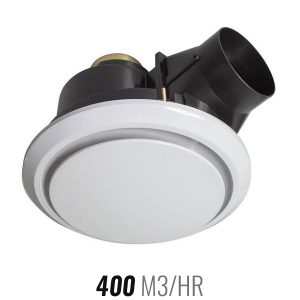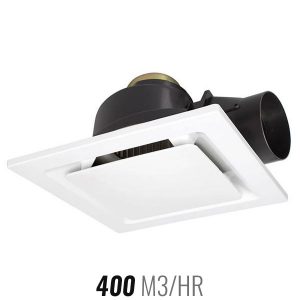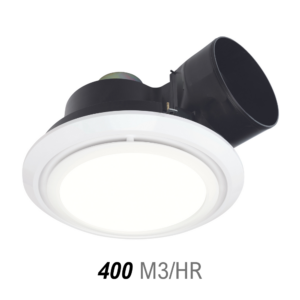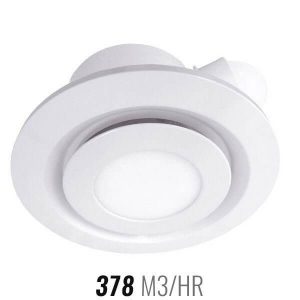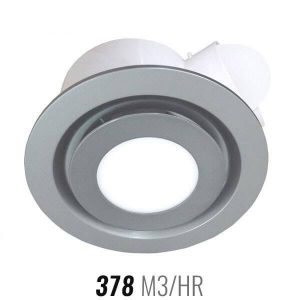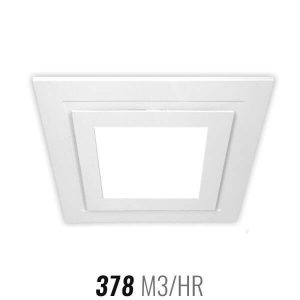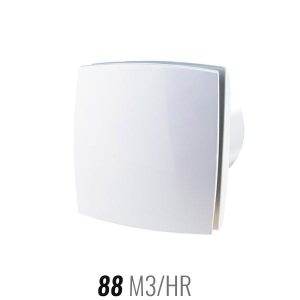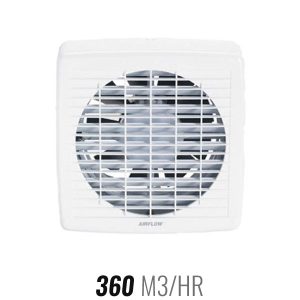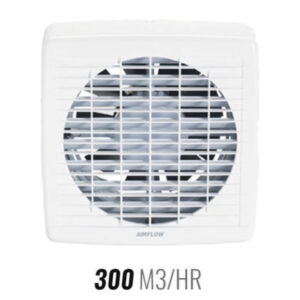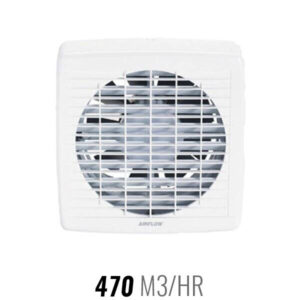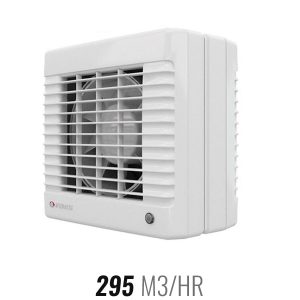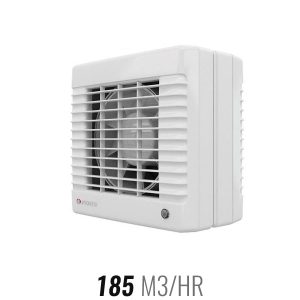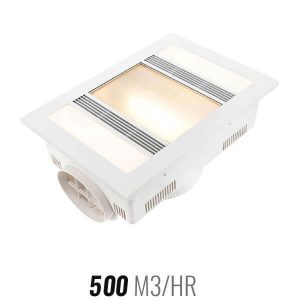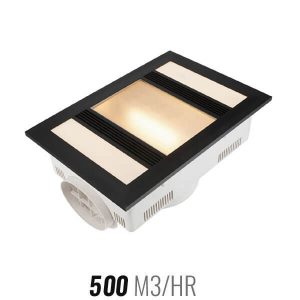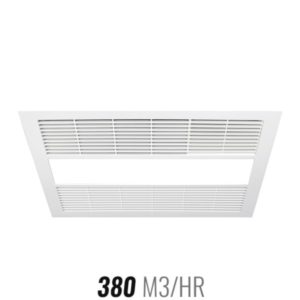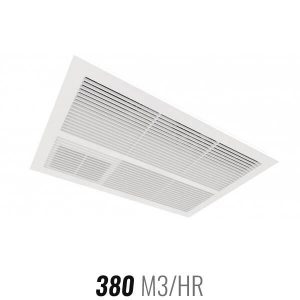How to choose an exhaust fan
How to Choose an Exhaust Fan
Bathrooms, kitchens and laundries all benefit from the addition of an exhaust fan. Condensation and moisture tend to build up in these areas because of the way we use them. Activities like cooking or showering create steam, which settles on walls and ceilings and other surfaces in the rooms.
Left unchecked, this can lead to mould growth and other long-term issues. The right exhaust fan can help prevent these issues by extracting air from the room. Depending on the factors outlined below, exhaust fans draw out moisture and odour along with air.
Opening a window also allows for air to leave the affected room, but it may take longer for unwanted steam to clear, as well as letting in lots of cold air in winter! For these reasons a mechanical exhaust fan is often a more favourable solution.
Even the best exhaust fan won’t necessarily eliminate steam from your bathroom immediately, but it will significantly improve your ventilation, and help keep your home healthy.
Our goal here is to help you choose a fan that will ventilate the area well enough to prevent longer-term issues. If you would like to discuss your own goals with us, don’t hesitate to contact our customer service team by phone or email.
Finding an exhaust fan to suit your needs
When it comes to choosing an exhaust fan, there are many factors to consider. Everything from the size of the room to the climate you live in can tell you something about the type of exhaust fan you need. In this guide we will cover the most common domestic ventilation options.
Type of Fan
Perhaps this is the easiest thing to take into account. You already know where you would like to install the fan, and in a lot of cases, this will dictate the type of fan you choose. However, it’s still good to be aware of all your options.
Ceiling Mounted Exhaust Fans
In Australia, the most popular exhaust fans are ceiling exhaust fans. These are often the easiest to install, particularly if you are replacing an old ceiling mounted fan (providing you find a model that matches your current hole size). We have some fantastic options in terms of aesthetics and also performance. Below are some of our most popular options:
-

Fanco Hybrid High Performance Square Ceiling Exhaust Fan – 150mm White
4.57 – 7 reviewsOriginal price was: $269.00.$229.00Current price is: $229.00. -

Fanco Hybrid High Performance Round Ceiling Exhaust Fan – 150mm Black
5.00 – 1 reviewsOriginal price was: $269.00.$229.00Current price is: $229.00. -
Fanco Luna Quiet Boost 250 Exhaust Fan – White
4.58 – 19 reviewsOriginal price was: $129.00.$99.00Current price is: $99.00. -
Fanco Metro Quiet Boost 250 Exhaust Fan – White
4.78 – 9 reviewsOriginal price was: $119.00.$99.00Current price is: $99.00.
Exhaust Fan with Light
Exhaust Fan with Light – Do you need a fan with a built-in light? There are many great models on the market, including units with built-in low wattage LED light panels. In many cases it makes a lot of sense to find a unit that will provide ventilation as well as lighting, particularly in a smaller bathroom. Below are some of our bestsellers:
-
Fanco Luna Quiet Boost CCT LED 250 Exhaust Fan – White
4.00 – 3 reviewsOriginal price was: $169.00.$149.00Current price is: $149.00. -
Ventair Airbus with LED Light 250 Ceiling Exhaust Fan White
5.00 – 2 reviewsOriginal price was: $303.00.$259.00Current price is: $259.00. -
Ventair Airbus with LED Light 250 Ceiling Exhaust Fan Silver
Original price was: $289.00.$199.00Current price is: $199.00. -
Ventair Airbus Square with CCT LED Light 250 Ceiling Exhaust Fan White
4.86 – 7 reviewsOriginal price was: $289.00.$249.00Current price is: $249.00.
Wall Exhaust Fans
Wall Exhaust Fans – Wall exhaust fans can be a practical solution if have limited ceiling space or if you simply have a preference for something wall mounted. Below are some of our bestsellers, the popular Chico range has been one of our best options for a number of years:
-
Chico Exhaust Fan 150mm White
5.00 – 8 reviewsOriginal price was: $159.00.$139.00Current price is: $139.00. -
Chico Exhaust Fan 100mm White
4.75 – 8 reviewsOriginal price was: $119.00.$99.00Current price is: $99.00. -
Maxair 150mm White Wall Exhaust Fan | 300 m3/hr
Original price was: $429.00.$379.00Current price is: $379.00.
Window Exhaust Fans
Window Exhaust Fans – These are popular in apartment blocks where they can be found in kitchens as well as bathrooms. The most common scenario is replacing an ‘old model’ and the most important consideration here is to source a model with a hole size requirement that is exactly the same, to avoid glazier costs.
-
Maxair 150mm White Window Exhaust Fan
Original price was: $469.00.$419.00Current price is: $419.00. -
Maxair Window Exhaust Fan 190mm White
Original price was: $559.00.$509.00Current price is: $509.00. -
Fanco Valerie 150 Window Exhaust Fan White
4.67 – 6 reviewsETA Early DecOriginal price was: $219.00.$199.00Current price is: $199.00. -
Fanco Valerie 125 Window Exhaust Fan White
Original price was: $199.00.$179.00Current price is: $179.00.
Exhaust Fan with Heat Lamps
Exhaust Fan with Heat Lamps – Looking for something with built-in heating? We have a huge selection! Heat lamps usually provide instant warmth, a great addition, especially for those cold winter mornings. Nowadays we have a wide range including some really elegant models with low profile fascia, unlike the traditional bulbous heat lamps! Below are some of our favorite examples.
-
Brilliant Marvel 3 in 1 Exhaust Fan with LED Light – White
4.71 – 7 reviewsOriginal price was: $359.00.$279.00Current price is: $279.00. -
Brilliant Marvel 3-in-1 Exhaust Fan with LED Light – Black
Original price was: $359.00.$279.00Current price is: $279.00. -
Ventair Sahara 4-in-1 Exhaust Fan White
4.60 – 20 reviewsOriginal price was: $759.00.$439.00Current price is: $439.00. -
Ventair Sahara 2-in-1 Bathroom Heater and Exhaust Fan – White
5.00 – 1 reviewsOriginal price was: $644.00.$409.00Current price is: $409.00.
Inline Fans
Inline Fan – Inline fans are high capacity units which perform well over long duct runs. Typically they are installed in a roof cavity and are connected to flexible ducting to an intake vent in the bathroom ceiling. They are a great high performance solution if you require a higher extraction rate, plus we have a huge range of decorative intake and outlet vents to complete a top quality system. Our pre packaged kits include everything you need to ventilate your bathroom.
The Most Important Question – Which Size Fan do I need? It starts with Room Size…
To choose the right exhaust fan, you need to know the size of the room. The exhaust fan needs to extract air to make space for fresh, clean air. So, it makes sense that room size relates to the strength of the fan you need. In the vast majority or residential installations, fresh air enters via a small gap under the door and this is adequate. Alternatively a door vent could be considered.
Every time the exhaust fan extracts the full volume of air in the room, you achieve one air change. The number of air changes to aim for depends on many factors, including what type of room. For example, in a bathroom, we suggest aiming for approximately 15 air changes per hour.
If you look at one of our exhaust fan product listings, you’ll see we measure exhaust fan capacity in m3/hr (cubic metres per hour). Look at this specification to see how many cubic meters of air a fan extracts in an hour. To work out how many air changes a fan will achieve based on room size, divide the fan’s capacity by the size of the room. The answer is the number of air changes possible with this setup. While there are other factors to consider, this information is a good start.
Step by step finding a fan with the right capacity
- Decide the number of air changes you’d like to achieve. We suggest aiming for 15 air changes in bathrooms and around 10 for toilets, but this is only a guide. It depends greatly on the environment.
- Measure the rooms length, width and height. Taking these measurements in meters will make things easier for you later because we measure our fans’ capacities in cubic meters.
- Multiply the length, width and height. Example: 2m long x 3m wide x 2.5m high = 15 m3
- Multiply the answer by the number of air changes you’d like to achieve.
Example: To find the capacity required to achieve 15 air changes in a 15m3 room, multiply 15 x 15 = 225. You’re looking for an exhaust fan with an approximate 225m3/hr capacity.
Please note the above article is intended as a guide, not as specific advice. Our general base recommendation is 15 air changes per hour for bathrooms. Based on our experience, extracting air at this rate prevents mould growth and condensation build-up in most installations. Please consider the factors below to decide whether you believe 15 air changes will be enough to meet your aims.
Other Factors to consider before choosing an exhaust fan:
Climate
Think of a window pane in winter. It’s cool, but when you switch on the heater, condensation forms on the glass as the warmer air meets the colder surface. The same effect happens on tiled walls and mirrors when you use a shower and the cooler these surfaces are, the more you’ll notice the condensation. No matter where you live, it’s likely you will notice some condensation in the bathroom. Still, there’s no denying that in some parts of Australia, winter temperatures dip lower than in other parts. Because of this, a bathroom in Melbourne or Hobart may visibly generate more condensation than one in Brisbane.
Steam Temperature
Hotter showers mean warmer steam. Warmer steam will create more condensation when it touches cool surfaces like your bathroom tiles or mirrors. Keep this in mind when you’re working out how many air changes you want to aim for.
Interior Design and building materials
If your room has lots of cool surfaces, like tiles or glass, you may require a higher extraction rate. For example a fully tiled floor to ceiling bathroom has more cool surfaces than a bathroom with tiles that just cover the shower area. Therefore a fully tiled room will visibly show more condensation than one that is partially tiled.
Expectations
The above two factors lead nicely into us talking about expectation levels and perception. No matter how powerful your exhaust fan is, it is unlikely that the fan will prevent ALL condensation from appearing. Simply because condensation will start to appear as soon as the warm air is in contact with a cooler surface, this happens faster when showers are warmer and temperatures are lower!
In fact it is very normal for a fan that is correctly specified in terms of extraction rate to still see visible condensation in the room and the mirror still fogging up, particularly if it’s a bathroom in winter and you have long hot showers! During these periods it may be a good idea to keep the fan running for approximately 10 – 15 minutes after you have left the room to assist with extraction.
Ducting
The further you duct your fan, the harder it will have to work. Over the lengths of a duct run, the fan’s pressure will start to drop off. If you need to run a long duct, get in touch with us to discuss your options. Best practice is to keep your duct run as short and direct as possible. Ensure that there are no unnecessary bends or twists in the ducting to maximise performance.
Secondly, remember that not all fans are ductable. Make sure that the fan you’re buying has a connection for ducting. This will be indicated on each of our exhaust fan listings individually. You can also find ducting in the right size listed as an accessory on the listing. We sell a comprehensive range of exhaust fan accessories.
If you use it correctly, your exhaust fan will assist in keeping your home healthy.
Useful Exhaust Fan Links:
- Ceiling Mounted Exhaust Fans
- Wall Mounted Exhaust Fans
- Window Mounted Exhaust Fans
- Exhaust Fans with Light / Heat Lamps
- Accessories
Updated on 5th April 2022
Still need assistance? Our specialists are happy to help! Click here to send us a contact form
